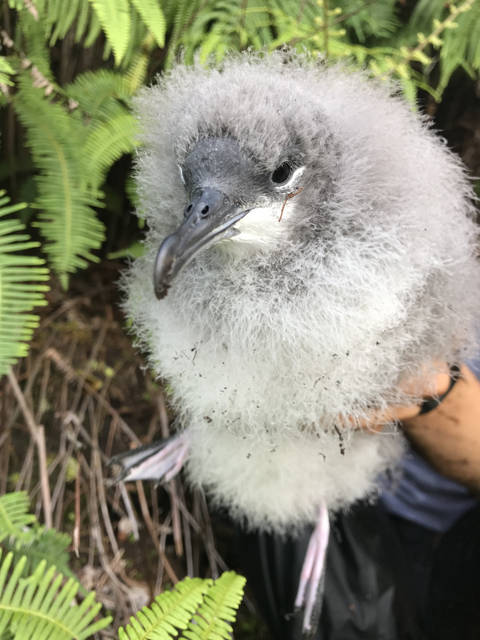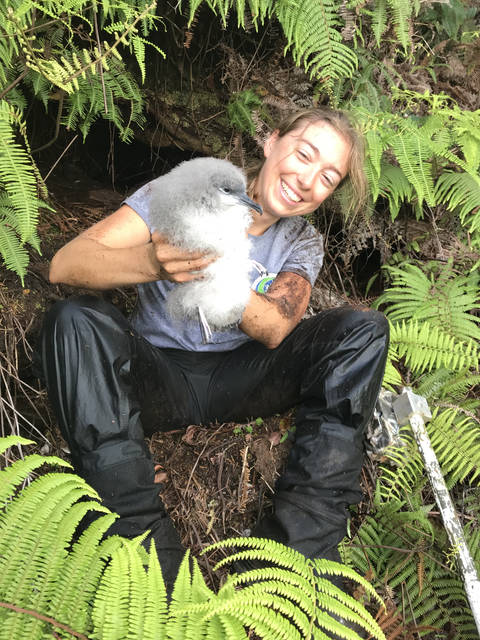They’re fuzzy, they’re endangered and there are now 19 of them growing in man-made burrows on Kauai’s North Shore.
They’re Newell’s shearwater (‘a‘o) chicks, and they make up the third round of chicks translocated from Kauai’s mountain burrows to a protected nesting site within a predator-proof fence in Kilauea Point National Wildlife Refuge.
“The first should start to fledge within a week or so,” said Andre Raine, project coordinator with Kauai Endangered Seabird Recovery Project. “They start fledging in October, end of September.”
The translocation project happened over two days — Sept. 11 and 12 — and eight of the birds came from Limahuli, nine from NaPali and two from Kilauea Point.
Rain and weather stretched the project over two days, as Raine and his team visited the burrows they’ve been monitoring for years, checking the chicks’ status monthly for predator issues and health.
The goal is to get the chicks before they emerge from their burrows. That’s because Newell’s shearwater chicks, and other seabird species, imprint on the place they’re born the first time they see the night sky, and the team wants the chicks to imprint on the burrows at Nihoku, not in the mountains.
Over time, this will create a breeding colony at Nihoku in a place that’s safe for nesting.
Newell’s shearwaters are likely to start returning to breeding colonies at 2 or 3 years of age, according to KESRP, but likely do not breed until they’re 5 or 6.
“This year was the first year there was a chance a bird might come back, though it’s early,” Raine said. “We’re hoping next year we’ll start seeing them return and start breeding and build that population up.”
Predators in the mountains are halting the usual breeding habits of the Newell’s shearwaters, which generally breed in high-density colonies, he said. At Nihoku there’s a chance to return to that norm.
The project to create the breeding colony is a five-year project that started in 2015 with the goal of relocating up to 20 Newell’s shearwaters and up to 20 Hawaiian petrels from the mountains to Nihoku every year.
Hawaiian petrels (‘ua‘u) are also endangered, with an estimate of about 20,000 individuals remain in the wild, including 4,500 breeding pairs.
The translocation is run concurrently with social attraction, which in theory will attract breeding birds as well.
In 2015, the first year of the project, the team translocated 10 Hawaiian petrels. Then, in 2016, the team translocated 20 Hawaiian petrels and eight Newell’s shearwaters chicks. In 2017, 21 Hawaiian petrels and 18 Newell’s shewarwaters were translocated to Nihoku.
Now that 19 new Newell’s shearwater chicks are growing in their burrows out at Nihoku, the team is gearing up to move 20 Hawaiian petrels on Oct. 16 and 17, with backup days scheduled for Oct. 18 and 19.
“We’ve got birds coming in from three or four different sites,” Raine said.
While the translocation program started in 2015, the Nihoku Ecosystem Restoration System was created in 2012 to protect coastal ecosystems and provide a predator-proof nesting area for native ground-nesting birds in Hawaii.
Laysan albatross (moli) and nene, the Hawaiian goose, are included on that list.
Project partners include KESRP and Pacific Rim Conservation, National Tropical Botanical Garden and American Bird Conservancy, National Fish and Wildlife Foundation, U.S. Fish and Wildlife Service and the Hawaii Department of Land and Natural Resources, and private partners.
•••
Jessica Else, environment reporter, can be reached at 245-0452 or at jelse@thegardenisland.com.




Why does this article avoid describing which “Predators” are responsible for killing these and other rare wild life? Can’t they just say its domestic and feral CATS?
Or is some cat loving idiot that wrote this article trying to hide the fact that there is an issue on November’s election ballot to address the problem of cats killing wild life and creating dangerous Toxiplasma virus in their feces that washes down to the oceans and responsible for killing more than half of the Hawaiian monk seals including threats to both locals and tourists who swim in those waters.